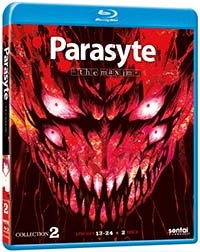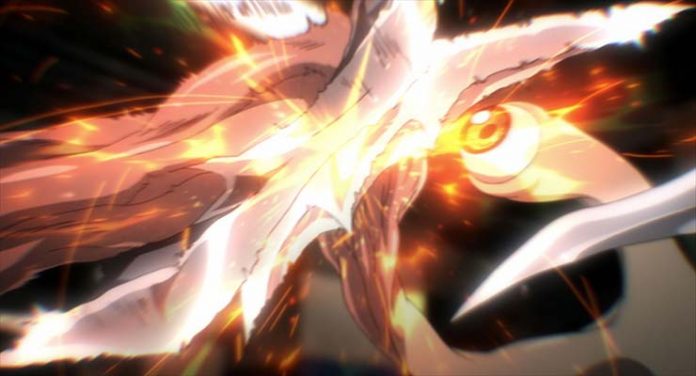
Collection 2 picks up with Shinichi at first seeming a bit more balanced and comfortable in his body, but it doesn’t take too long for things to start to go horribly wrong as he finds himself the target of a seemingly unstoppable parasite whose powers Migi’s are no match for. One of the stranger turns in the second half of this series is the evolution of the parasitic character Tamura Reiko. Reiko started out as one of Shinichi’s teachers, an undercover observer, as viewers of the series will recall, and she seems to have always been set apart from most of the other parasites as more of a thinking character. She killed Shinichi’s parents, and even though offered him and Migi a free pass, if you will, simply so she could observe them, she has always seemed somewhat of a threat. Now, having given birth to Mr. A’s baby, she starts to actually grow attached to the human child beyond merely an observational capacity.
[envira-album id=”90706″]
Without giving too much away for those who may not have seen the entre series already, I think that Parasyte succeeds on multiple levels, especially after wrapping up episodes 13-24, because it explores on psychological level the definition of being human. Are the parasites human or not? Does it require having emotions to be human? Because you have other biological entities residing in you and perhaps controlling some of your thoughts, does it make you less human? Shinichi goes through a crisis in these episodes – a crisis of self-doubt, of what it would mean to live without Migi, after so long wishing he could. Is Shinichi fully human, half-human, or not human at all?
Parayste can be horrifyingly grotesque in its animation, the way people morph into monstrous alien creatures, often times popping right out of their heads. Migi takes on multiple forms from Shinichi’s hand, and talks to him in anthropomorphized form throughout the series, and it’s very surreal. The animation from Madhouse is stupendous, completely beautiful even as it can work its way into your nightmares.
While the violence of the series doesn’t necessarily rise to the level of series such as Corpse Party: Tortured Souls or Hellsing Ultimate, there is definitely some, but it is more of a fantasy, sci-fi nature, than the visceral, bloody, realistic violence of those series. Those looking for a slasher type series won’t get their fix here, but for anyone else, Parasyte: The Maxim is a cleverly done and wonderfully animated horror series.
The Video
We get more of the same of what Sentai Filmworks delivered with Collection 1 at the end of last year with this fine transfer of Collection 2. The eye-popping digital animation for Parasyte is once again presented in an AVC 1080p encodement that is free from major flaws, is crisp and nuanced, and suffers only from slight hints of color banding in some of the darker areas.
The Audio
Parasyte is one of the rare releases from Sentai Filmworks that comes with an English dub in 5.1. That said, while the DTS-HD Master Audio 5.1 track in English is very enjoyable and entering, though not close to being on par with the best reference releases for some of the Hollywood blockbuster films on disc, the English cast just doesn’t compete with the Japanese cast on talent. The Japanese mix is provided in the standard DTS-HD Master Audio 2.0 stereo, and while this mix does collapse a bit after hearing the 5.1, it is no slouch. For the 5.1, the often pulsating electronic score courses through each channel and engulfs you in lush, atmospheric sounds. The dialogue is full and clear, and there’s a good amount of low-end. But the Japanese DTS-HD Master Audio 2.0 stereo track is very good for a stereo mix also. As is often the case with Sentai releases, the dynamic range is excellent and we get a good bit of stereo spread plus clean dialogue as well.
The Supplements
There is nothing beyond the clean openings and closings and additional Sentai Filmworks trailers.
The Final Assessment
The second collection of episodes is an amazing wrap-up to this psychological paranormal fantasy series. Parasyte – The Maxim hits on many levels, be it the character development, the animation, or the plot. Sentai Filmworks’ Blu-ray is an excellent release.
Be the first to leave a review.

